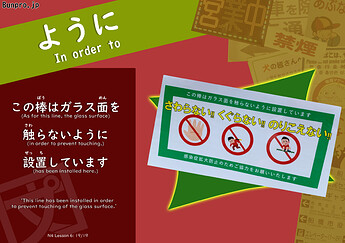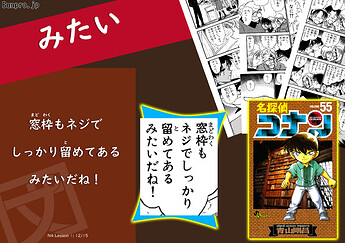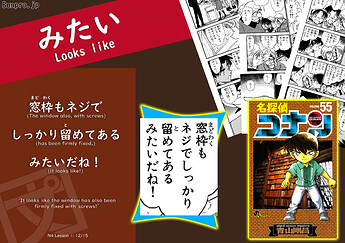July 13th
t
So that you won’t touch this glass pole, we are installing it. (???)
never seen 設置 and the definition along with しています is completely throwing me off my game here haha
...
This pole is installed in order to prevent touching the glass surface.
Summary
This pole is installed in order to not touch the front glass.
Use
早く起きるように、早く寝るつもりだ。
July 13th Translation
Notes: When instructional, ように often has the nuance of prevention/permission, depending on if it is ように, or ないように. This comes from the ‘beyond the will of the speaker’ nuance that is explained along with this grammar point. A specific action is desired, but not controllable.
...
Looks like the window frame is tightly fastened by a screw too!
Summary
Looks like the window frame is also fastened/screwed tightly, right?
やさしいみたいけど、実は難しいです。
棒 makes sense here if it’s used as a line, never saw the word before only remember it from DBZ so I figured it meant pole. One slight question I have would be the difference of している vs していた - what would the image mean if the past tense had been used instead of て-form?
t
Looks like the windows frame is also tightened with a screw. Grammatically this isn’t that tough, but so many words that I’ve never seen threw me off. Never seen screw written like that, and 確 was used in a way I’ve never seen. Still fun to learn these new words!
I thought pole too, it’s also saying くぐらない (don’t go under) and 乗り越えない (don’t climb over) so a pole makes more sense to me (thinking waist level here), not like a line on the ground. This would be far easier with the visual.
Translation
It looks like as if the window frame had been tightly nailed with a screw.
Use case
前の文法のところの「棒」の意味は私達に誤解されたみたいですね。
Answers to questions
I wouldnt worry at all about your guesses guys, they are equally as correct as ‘line’. In this case, 棒 does mean a pole, but it would be more like a pole thing with rings on the end that go over either end of a traffic cone (really common in Japan for establishing a perimeter). Like if I set up a velvet rope around a display at a museum, the sign might say ‘don’t cross the line’, but it’s not really a line, it’s a rope. Same principal here. Remember that these translations are just interpretations, so as long as yours is on the same track, you can consider it correct.
As for the tense question, remember that ている is a little bit different to the continuous form in English, and many actions are considered to be taking place even when they would be considered to be finished in English. For 設置, (installed/established), it’s more like ‘has been established’ in English, yes the action itself is finished, but the result of that action is still in effect. ていた would be more like ‘had been established’, it was there, it remained there for a certain amount of time, but is now gone.
Both of your explanations make SO much sense, thank you! I think a lot of the time I fall into that trap where I try to dissect everything bit by bit instead of looking at the overall message to help me understand how the things are being used. My guess of the pole wouldn’t make sense in any situation because that’s not a likely scenario to happen haha, these out of context examples really do help push the brain to think of what possibilities make the most sense.
I’m definitely grateful for it though, the forums here have been really good for picking up on the different ways people interpret or analyze something. I’ve learned something new in addition to the title point for all of these grammar in the wild posts and it’s all thanks to the discussions you’ve all been having 
July 14th
Note: しっかり is a powerhouse word in Japanese! It has many different translations, but most of the time it just boils down to ‘taut’. Something that is tight, does not have any slack, and does not give an inch (mentally or physically!)
t
(explaining) I’m starving!
Summary
I’m really starving!
僕もお腹空いたんだよ。
...
I’m kinda hungry.
Whoops
Looks like I misunderstood なんだよ part.
Translation
Because i’m starving.
Use case
猫は出かけたがらなさそうだ。外は寒いんだ。





